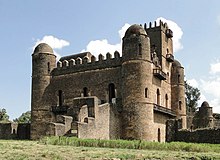Fasilides of Ethiopia
| Fasilides | |
|---|---|
| Emperor of Ethiopia | |

|
|
| Reign | 1632 – 18 October 1667 |
| Predecessor | Susenyos I |
| Successor | Yohannes I |
| Born | 20 November 1603 Magazaz |
| Died | 18 October 1667 |
| House | House of Solomon |
| Father | Susenyos I |
| Mother | Sultana Mogassa |
| Religion | Ethiopian Orthodox Tewahedo |
Fasilides (Ge'ez ፋሲልደስ Fāsīladas, modern Fāsīledes; 20 November 1603 – 18 October 1667), also known as Fasil or Basilide, was emperor of Ethiopia from 1632 to 18 October 1667, and a member of the Solomonic dynasty. His throne name was ʿAlam Sagad (Ge'ez ዓለም ሰገድ ʿĀlam Sagad, modern ʿĀlem Seged), meaning "to whom the world bows". He was the son of Emperor Susenyos I and Empress Sultana Mogassa, born at Magazaz in Shewa before 10 November 1603. His paternal grandfather's name was also Fasilides.
Fasilides was proclaimed emperor in 1630 during a revolt led by Sarsa Krestos, but did not reach the throne until his father abdicated in 1632. Once he became emperor, Fasilides immediately restored the official status of the traditional Ethiopian Orthodox Church. He sent for a new abuna from the Patriarch of Alexandria, restoring the ancient relationship that had been allowed to lapse. He confiscated the lands of the Jesuits at Dankaz and elsewhere in the empire, relegating them to Fremona. When he heard that the Portuguese bombarded Mombasa, Fasilides assumed that Afonso Mendes, the Roman Catholic prelate, was behind the act, and banished the remaining Jesuits from his lands. Mendes and most of his followers made their way back to Goa, being robbed or imprisoned several times on the way. In 1665, he ordered the "Books of the Franks"—the remaining religious writings of the Catholics—burnt.
He is commonly credited with founding the city of Gondar in 1636, establishing it as Ethiopia's capital. Whether or not a community existed here before he made it his capital is unknown. Amongst the buildings he had constructed there are the beginnings of the complex later known as Fasil Ghebbi, as well as some of the earliest of Gondar's fabled 44 churches: Adababay Iyasus, Adababay Tekle Haymanot, Atatami Mikael, Gemjabet Mariyam, Fit Mikael, and Qeddus Abbo. He is also credited with building seven stone bridges in Ethiopia; as a result all old bridges in Ethiopia are often commonly believed to be his work.
...
Wikipedia
